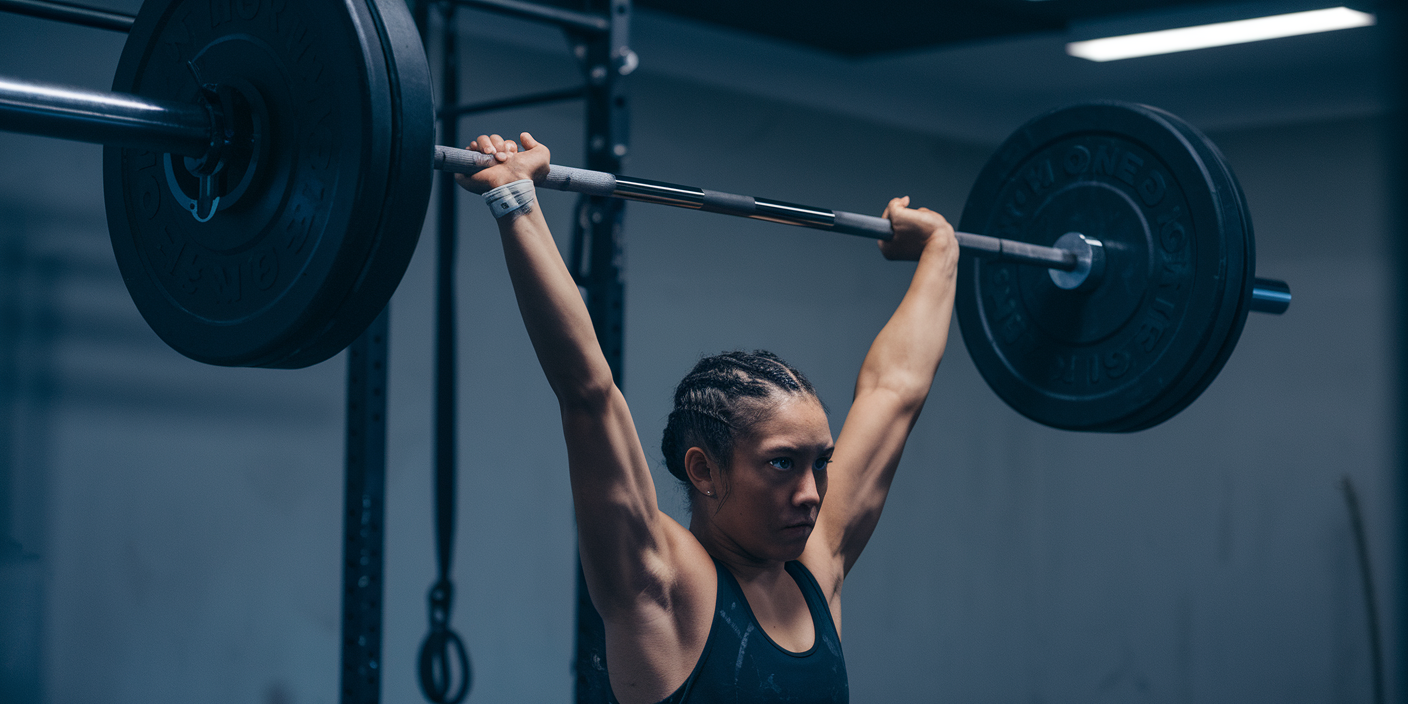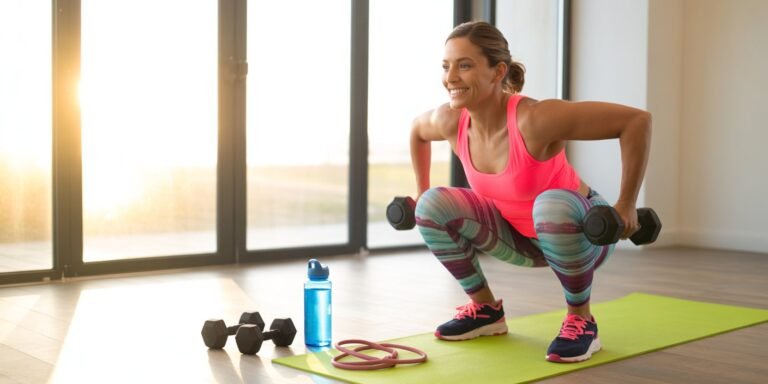When it comes to fitness, you might wonder: “Can’t I just work out at home?” The truth is, while home workouts are convenient, going to the gym offers unique benefits that are hard to match anywhere else.
From access to professional equipment to the energy of a motivating environment, gym workouts provide the tools and structure you need to reach your fitness goals faster.
At the gym, you’ll find a variety of machines and free weights that allow you to train every muscle group effectively. Whether your goal is building muscle, losing weight, or improving endurance, having access to the right equipment ensures that your workouts stay challenging and balanced.
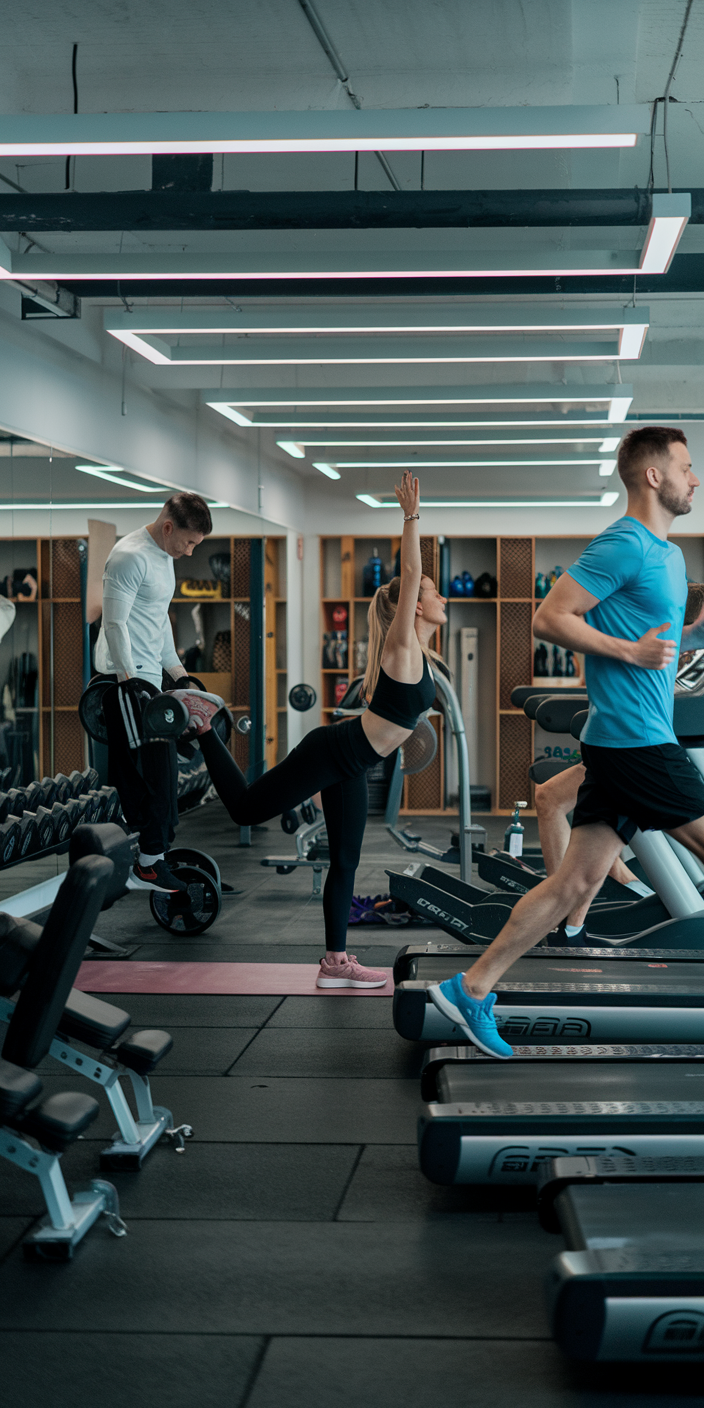
Plus, gyms often offer classes, trainers, and resources that help you push beyond your comfort zone.
But the benefits go beyond just physical results. The gym is a place of focus and accountability. When you step into that space, you mentally switch into “workout mode,” which makes it easier to stay consistent.
The community aspect — seeing others train hard — can also inspire you to push a little further than you would at home.
In short, gym workouts are essential because they combine structure, variety, motivation, and effectiveness in a way that accelerates progress.
Benefits of Gym Workouts
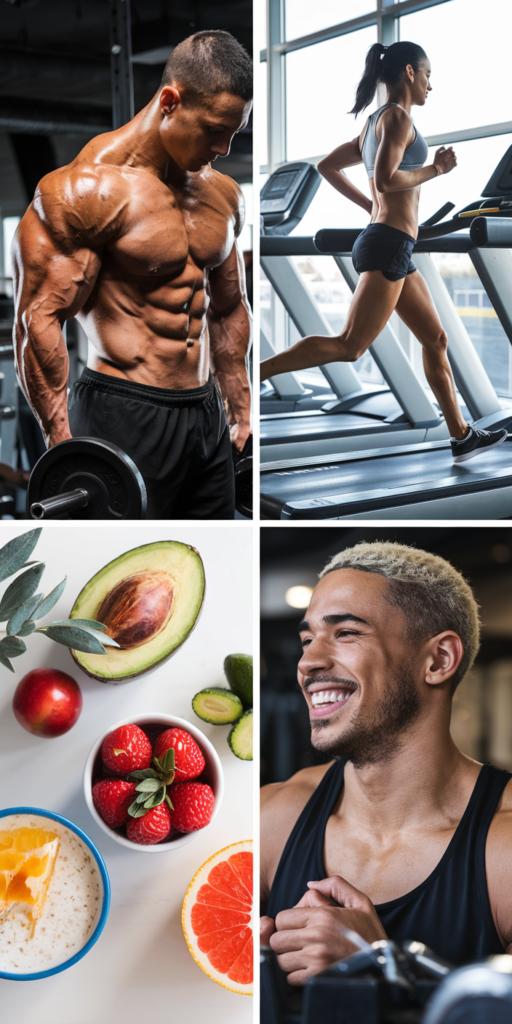
Gym workouts offer far more than just a place to lift weights or run on a treadmill—they provide a structured environment, access to equipment, and a community that can boost motivation and results.
Incorporating regular gym sessions into your routine has numerous physical, mental, and lifestyle benefits.
1. Builds Lean Muscle & Strength
Using free weights, machines, or resistance bands helps you develop muscle mass, increase strength, and improve overall body composition.
More muscle means a higher metabolism, so your body burns more calories even at rest. Strength training also supports bone density, reducing the risk of osteoporosis over time.
2. Burns Calories & Supports Fat Loss
Cardio machines, HIIT circuits, and group fitness classes provide structured ways to burn calories efficiently.
Combining strength and cardio exercises helps reduce body fat while preserving lean muscle, leading to a toned and fit physique.
3. Improves Cardiovascular Health
Regular gym workouts that include cardio activities like running, cycling, or rowing strengthen the heart, improve circulation, and enhance lung capacity.
This reduces the risk of heart disease, lowers blood pressure, and boosts endurance.
4. Increases Flexibility & Mobility
Stretching routines, yoga classes, and functional training exercises available in gyms improve flexibility, balance, and joint mobility.
This decreases the risk of injuries in daily life and enhances overall movement efficiency.
5. Boosts Mental Health & Reduces Stress
Exercise releases endorphins, the “feel-good” hormones, which help combat stress, anxiety, and depression.
Gym workouts also provide a structured routine that can improve focus, discipline, and confidence.
6. Access to Equipment & Guidance
Gyms provide variety and versatility with machines, free weights, resistance bands, and functional training tools.
Many gyms also offer personal trainers or group classes to guide proper form, design effective workouts, and prevent plateaus.
7. Encourages Consistency & Motivation
Being in a dedicated environment with like-minded people keeps you accountable and motivated.
Scheduled workouts, group classes, and seeing others working hard can push you to stay consistent and committed to your fitness goals.
Pro Tip: Combine strength training, cardio, and flexibility exercises during your gym sessions for a well-rounded fitness routine. Consistency is key—aim for 3–5 gym workouts per week to experience the full spectrum of benefits.
Best Gym Workouts for Strength & Muscle Growth
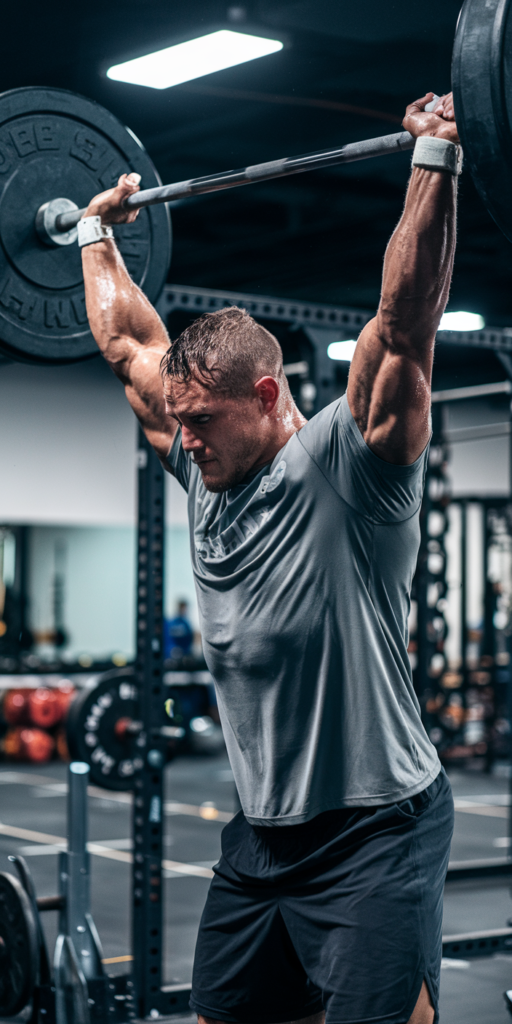
Building strength and muscle is a common goal for gym-goers, whether you’re a beginner or an experienced lifter.
The key is following structured workouts, using proper form, and focusing on progressive overload. Below, we’ve outlined the best gym exercises, how to do them correctly, and tips for maximizing muscle growth.
1️⃣ Squats (Targets: Quads, Glutes, Hamstrings, Core)
Squats are the king of lower-body exercises. They target multiple muscle groups, increase core stability, and improve overall strength.
How to Do It:
- Stand with feet shoulder-width apart, barbell on upper back or dumbbells at your sides.
- Push hips back and bend knees to lower your body as if sitting in a chair.
- Go down until thighs are parallel to the floor, then push through your heels to return to standing.
- Keep your chest upright and back straight.
Sets & Reps: 3–4 sets of 8–12 reps
Pro Tip: Add weight gradually to avoid injury and trigger progressive overload.
2️⃣ Deadlifts (Targets: Hamstrings, Glutes, Back, Core)
Deadlifts are a full-body exercise that strengthens your posterior chain and improves posture.
How to Do It:
- Stand with feet hip-width apart, barbell over mid-foot.
- Hinge at the hips with a straight back and grip the bar just outside your knees.
- Lift by straightening your hips and knees, keeping the bar close to your body.
- Lower back down slowly with control.
Sets & Reps: 3–4 sets of 6–10 reps
Pro Tip: Focus on form over weight; rounding your back increases injury risk.
3️⃣ Bench Press (Targets: Chest, Shoulders, Triceps)
The bench press is a classic upper-body strength exercise.
How to Do It:
- Lie flat on a bench with feet planted.
- Grip the bar slightly wider than shoulder-width.
- Lower the bar to your chest, then press upward until arms are fully extended.
Sets & Reps: 3–4 sets of 8–12 reps
Pro Tip: Use a spotter or safety bars when lifting heavy.
4️⃣ Pull-Ups or Lat Pulldowns (Targets: Back, Biceps, Shoulders)
Pull-ups build a strong back, while lat pulldowns are a beginner-friendly alternative.
How to Do Pull-Ups:
- Grip the bar shoulder-width apart, palms facing away.
- Pull up until your chin clears the bar, then lower slowly.
Lat Pulldown Alternative:
- Sit at the machine, grip the bar wide, and pull to chest level.
- Control the weight back up.
Sets & Reps: 3 sets of 6–12 reps
Pro Tip: Engage your lats by pulling shoulders down and back rather than using only your arms.
5️⃣ Overhead Shoulder Press (Targets: Shoulders, Triceps)
Strengthens the deltoids and stabilizes your upper body.
How to Do It:
- Sit or stand holding dumbbells at shoulder height.
- Press overhead until arms are fully extended.
- Lower slowly back to start.
Sets & Reps: 3–4 sets of 8–12 reps
Pro Tip: Keep your core engaged to avoid arching your back.
6️⃣ Barbell Rows (Targets: Back, Biceps, Rear Delts)
Barbell rows strengthen the upper back and improve posture.
How to Do It:
- Hinge at the hips with knees slightly bent, holding a barbell with overhand grip.
- Pull the bar toward your lower chest, squeezing shoulder blades together.
- Lower with control.
Sets & Reps: 3–4 sets of 8–12 reps
Pro Tip: Avoid jerking the weight; smooth motion maximizes engagement.
7️⃣ Leg Press (Targets: Quads, Glutes, Hamstrings)
A great machine-based exercise for beginners or as a squat complement.
How to Do It:
- Sit with feet shoulder-width on the platform.
- Lower platform slowly by bending knees to ~90 degrees.
- Push back to starting position.
Sets & Reps: 3–4 sets of 10–15 reps
Pro Tip: Don’t lock your knees at the top to protect joints.
Tips for Maximum Strength & Muscle Growth
- Progressive Overload: Gradually increase weight or reps over time.
- Proper Form: Avoid ego lifting; safety and effectiveness come first.
- Rest & Recovery: Give each muscle group at least 48 hours before retraining.
- Nutrition Matters: Consume sufficient protein and calories to support muscle repair and growth.
- Consistency is Key: Strength and muscle development take weeks and months, not days.
Pro Tip: Combine compound exercises like squats, deadlifts, and bench presses with isolation moves (bicep curls, tricep extensions, lateral raises) for a balanced, full-body routine.
1. Squats
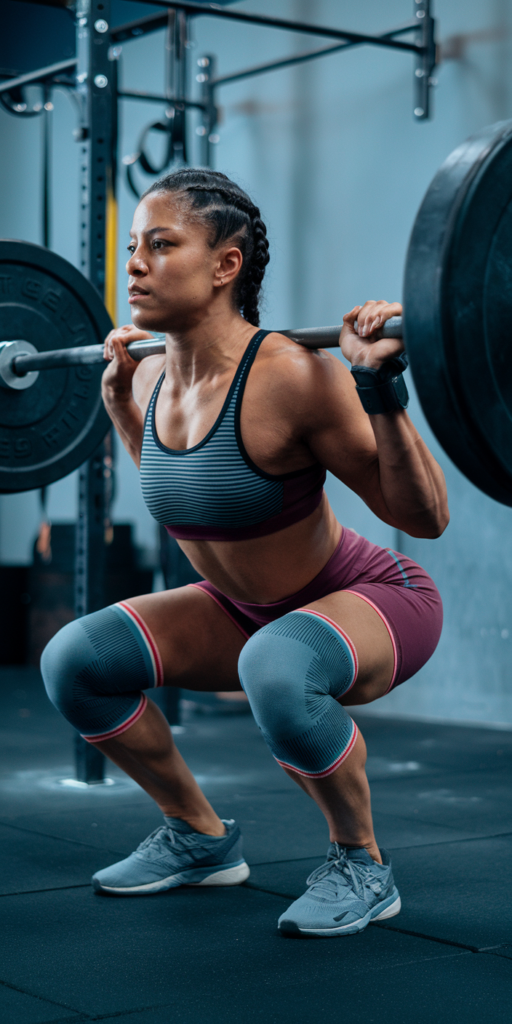
Squats are one of the most effective compound exercises for building lower body strength, improving mobility, and increasing overall muscle mass.
They engage multiple muscle groups at once, including the quads, glutes, hamstrings, and core, making them a cornerstone of any strength-focused gym routine.
How to Do It Properly:
- Stand with your feet shoulder-width apart and toes slightly turned out.
- Hold a barbell across your upper back, or hold dumbbells at your sides for added resistance.
- Engage your core and keep your chest up.
- Push your hips back and bend your knees, lowering your body as if sitting into a chair.
- Descend until your thighs are parallel to the floor (or as far as comfortable).
- Press through your heels to return to the starting position.
- Repeat with controlled motion—avoid bouncing at the bottom.
Sets & Reps: 3–4 sets of 8–12 reps
Pro Tips:
- Keep your knees tracking over your toes, not collapsing inward.
- Focus on depth and form rather than adding heavy weight too quickly.
- Activate your glutes at the top of each rep for maximum engagement.
Squats not only build muscle but also boost testosterone and growth hormone release, helping you gain overall strength and power.
2. Bench Press
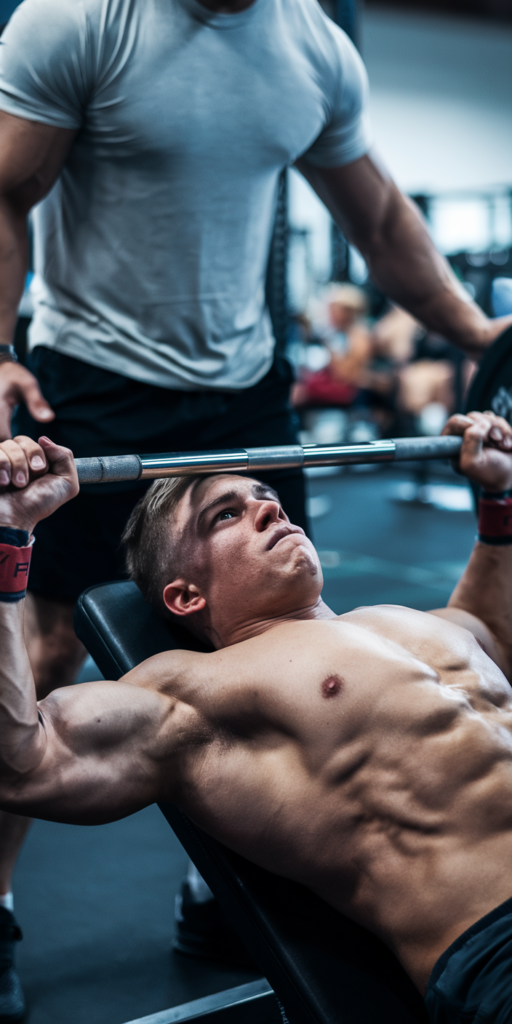
The bench press is widely considered one of the most effective upper-body strength exercises.
Not only does it help you build a powerful and defined chest, but it also strengthens your shoulders and triceps, making it a cornerstone exercise for anyone aiming to improve upper-body mass and functional strength.
Beyond aesthetics, a strong chest and triceps enhance everyday movements like pushing, lifting, or even carrying heavy objects.
How to Do It Properly:
- Setup: Lie flat on a bench with your feet firmly planted on the floor. Ensure your back is slightly arched naturally, and your shoulder blades are pinched together to provide a stable base.
- Grip: Grab the barbell with hands slightly wider than shoulder-width apart. This ensures proper chest activation while minimizing stress on the shoulders.
- Lowering the Bar: Slowly lower the bar toward your mid-chest. Keep your elbows at approximately a 45-degree angle to your torso, which reduces the risk of shoulder injuries and engages the chest muscles effectively.
- Pressing Up: Push the bar upward until your arms are fully extended, focusing on contracting your chest muscles. Avoid locking your elbows aggressively, which can place unnecessary stress on the joints.
- Controlled Motion: Keep every rep slow and controlled. Avoid bouncing the bar off your chest, as this reduces effectiveness and increases injury risk.
Sets & Reps: 3–4 sets of 8–12 reps is ideal for building muscle and strength, but you can adjust weight and reps depending on your goals.
Lower reps with heavier weight (4–6 reps) focus more on strength, while higher reps with moderate weight (12–15 reps) help with muscle endurance and hypertrophy.
Pro Tips for Maximum Results:
- Use a Spotter or Safety Bars: Especially important if you’re lifting heavy to prevent accidents.
- Engage Your Core: Tighten your abs and glutes to maintain stability and reduce stress on your lower back.
- Mind-Muscle Connection: Focus on squeezing your chest as you press up; this maximizes activation and growth.
- Warm-Up Properly: Use lighter sets first to prepare your muscles and joints, reducing the risk of injury.
Why It Matters:
The bench press doesn’t just make your chest look stronger—it also improves upper-body pushing power, enhances posture, and contributes to better performance in sports and daily activities.
Incorporating it consistently into your routine ensures balanced upper-body strength and supports overall muscle development.
3. Deadlifts
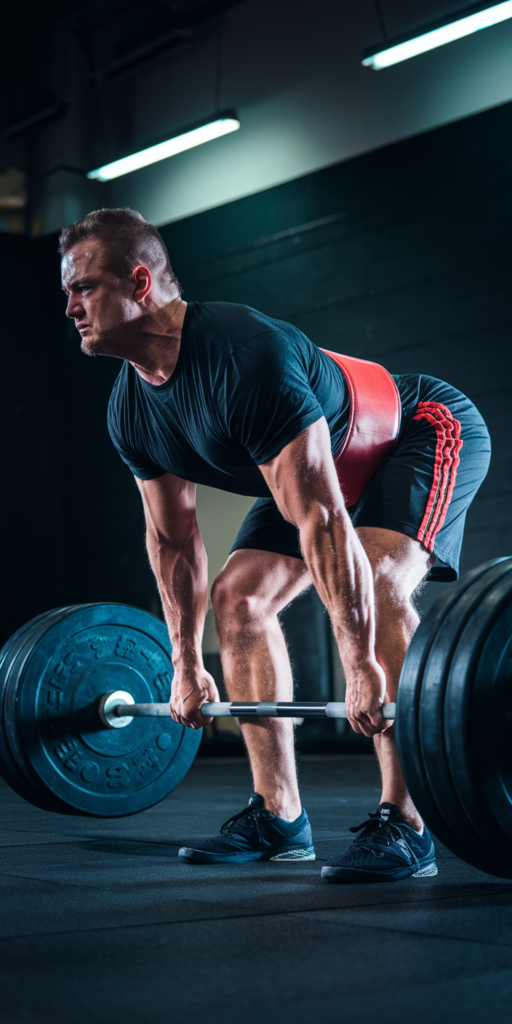
Deadlifts are often called the king of all strength exercises for a reason. This full-body movement targets multiple muscle groups, including the hamstrings, glutes, lower back, traps, and core.
Performing deadlifts regularly builds serious strength, improves posture, enhances athletic performance, and increases overall muscle mass.
Unlike isolation exercises, deadlifts train your body to work as a unit, which translates to better functional strength for everyday tasks like lifting, bending, or carrying.
How to Do It Properly:
- Setup: Stand with your feet hip-width apart and the barbell over the middle of your feet. Keep your toes pointing slightly outward.
- Grip & Position: Bend at the hips and knees to grip the bar just outside your knees with either an overhand or mixed grip. Keep your chest lifted, shoulders slightly in front of the bar, and back straight.
- Engage Your Core: Tighten your abs and brace your core before lifting to protect your lower back.
- Lift: Push through your heels, extending your hips and knees simultaneously. Keep the barbell close to your body as you lift to full standing position.
- Lowering the Bar: Hinge at the hips first, then bend your knees slightly, lowering the bar slowly and with control back to the floor. Avoid rounding your back at any point.
Sets & Reps: 3–4 sets of 6–10 reps is ideal for building strength and muscle. Beginners can start with lighter weight to master form before progressing to heavier loads.
Pro Tips for Maximum Results:
- Focus on Form Over Weight: Correct technique is far more important than lifting heavy, especially for beginners. Improper form can lead to serious injury.
- Engage Your Glutes & Hamstrings: Think about pushing your hips forward at the top of the lift to fully activate your posterior chain.
- Warm-Up Thoroughly: Dynamic stretches and lighter warm-up sets help prevent injuries.
- Progressive Overload: Gradually increase the weight or reps over time to continuously challenge your muscles.
- Use Chalk or Straps if Needed: For heavier lifts, chalk or lifting straps can improve grip and allow you to lift safely.
Why It Matters: Deadlifts are unparalleled for building overall strength, core stability, and muscle mass.
They improve athletic performance, enhance posture, and increase your metabolic rate, making them an essential exercise in any strength and muscle-building program.
4. Shoulder Press
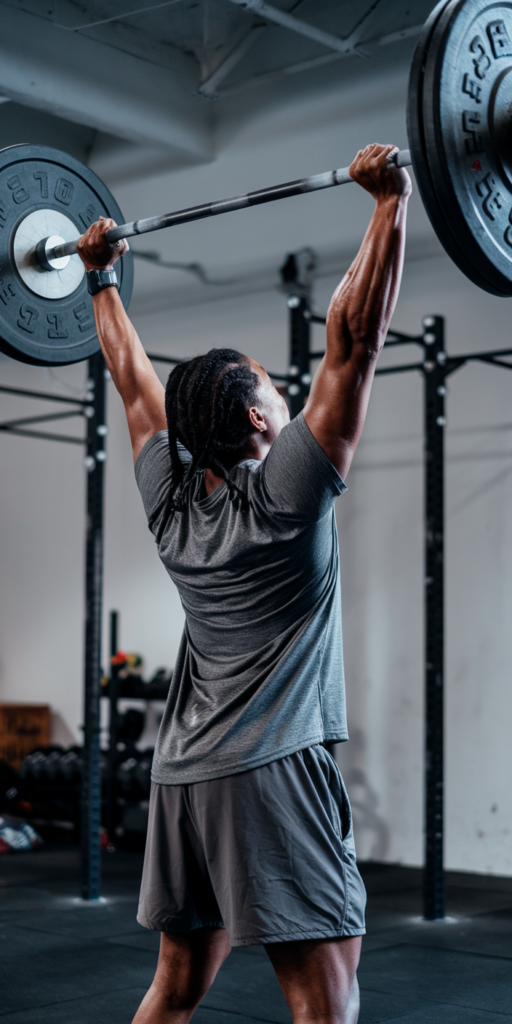
The shoulder press is a powerful upper-body exercise that primarily targets the deltoids while also engaging the triceps and upper chest.
It’s essential for building strong, well-rounded shoulders, improving posture, and enhancing overall pressing strength.
Whether you’re standing or seated, the shoulder press helps develop muscular stability and functional upper-body power.
How to Do It Properly:
- Setup: Sit on a bench with back support or stand with feet shoulder-width apart. Hold a dumbbell in each hand at shoulder height, palms facing forward, or use a barbell.
- Engage Your Core: Brace your core and glutes to prevent arching your lower back, maintaining a neutral spine.
- Press: Push the dumbbells or barbell upward until your arms are fully extended overhead, but avoid locking out the elbows aggressively.
- Lower Slowly: Bring the weights back down to shoulder height with control. Keep the motion smooth and deliberate.
- Breathing: Inhale as you lower the weights, exhale as you press upward.
Sets & Reps: 3–4 sets of 8–12 reps
Pro Tips for Maximum Results:
- Use Dumbbells for Balanced Strength: Dumbbells allow each arm to work independently, reducing imbalances compared to a barbell.
- Avoid Overarching Your Back: Keep your ribs down and abs engaged to protect your spine.
- Control the Weight: Focus on slow, controlled reps rather than using momentum to lift heavier loads.
- Warm-Up First: Shoulder mobility exercises or light dumbbell presses help prevent injuries.
Why It Matters: Strong shoulders improve upper-body aesthetics, functional strength, and posture.
The shoulder press also enhances performance in other lifts like bench presses and push-ups, making it a critical exercise for overall upper-body development.
5. Pull-Ups
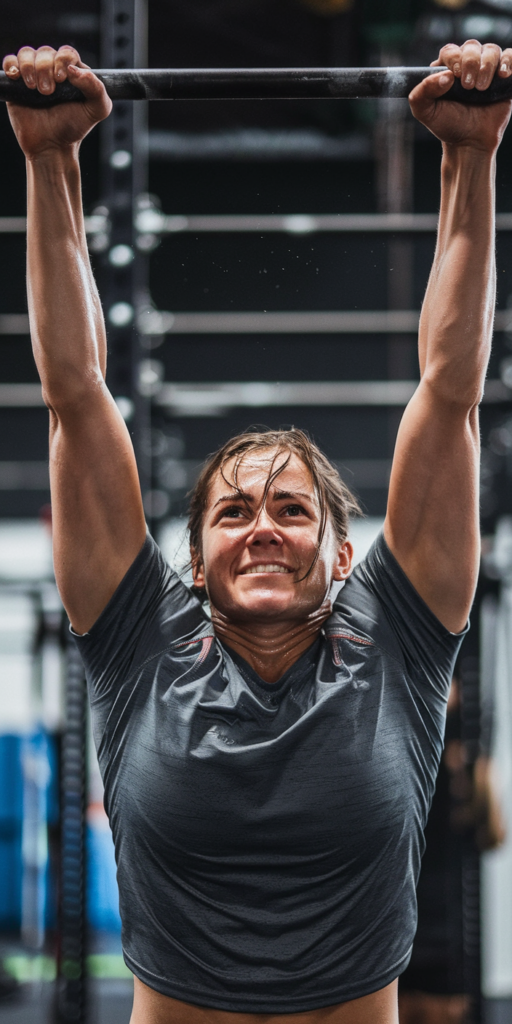
Pull-ups are one of the most effective bodyweight exercises for developing a strong, wide back and toned arms.
They primarily target the latissimus dorsi (lats) while also engaging the biceps, shoulders, and core.
Pull-ups are not only excellent for building upper-body strength but also improve grip strength and functional movement patterns, which carry over into daily activities and other gym lifts.
How to Do It Properly:
- Grip the Bar: Use an overhand grip (palms facing away) with hands slightly wider than shoulder-width apart. You can also use a neutral grip (palms facing each other) for variation.
- Engage Your Core: Tighten your abs and slightly retract your shoulder blades to stabilize your body.
- Pull Up: Pull your body upward until your chin clears the bar. Focus on engaging your back muscles rather than relying solely on your arms.
- Lower with Control: Slowly lower yourself back to the starting position until your arms are fully extended. Avoid swinging or using momentum.
- Breathing: Exhale as you pull up, inhale as you lower down.
Sets & Reps: 3–4 sets of 6–12 reps depending on your strength level. Beginners can use resistance bands for assistance or try inverted rows to build the necessary strength.
Pro Tips for Maximum Results:
- Mind-Muscle Connection: Think about “pulling your elbows down” rather than just pulling with your hands to activate the lats fully.
- Avoid Jerking or Kipping (Unless Training for CrossFit): Strict form ensures better muscle engagement and reduces risk of injury.
- Progress Gradually: Add weighted pull-ups with a dip belt or dumbbell between your feet as you get stronger.
- Warm-Up Properly: Shoulder mobility exercises and light band pull-aparts help prevent strain.
Why It Matters:
Pull-ups build functional strength, improve posture, and enhance upper-body aesthetics.
They’re a compound exercise that engages multiple muscles simultaneously, making them highly effective for overall strength and muscle growth.
6. Leg Press
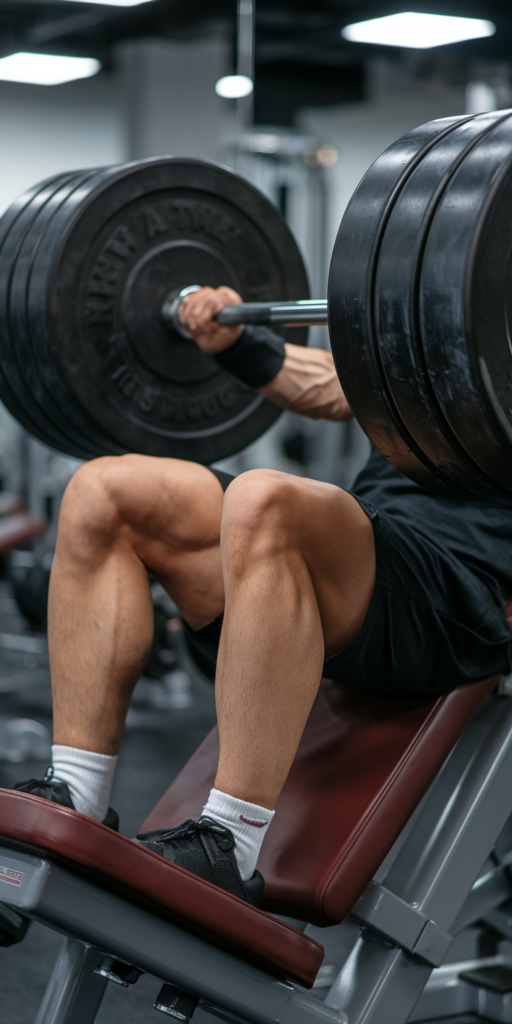
The leg press is a machine-based lower-body exercise that effectively targets the quads, glutes, and hamstrings.
It’s an excellent complement to squats, especially for beginners or those looking to add volume to their leg workouts without placing too much strain on the lower back.
The controlled movement allows you to lift heavier loads safely while focusing on muscle activation.
How to Do It Properly:
- Setup: Sit on the leg press machine with your back flat against the pad. Place your feet shoulder-width apart on the platform.
- Position Your Feet: To target the quads more, place your feet lower on the platform; for glutes and hamstrings, place your feet higher.
- Lower the Platform: Slowly bend your knees to lower the platform until your legs form approximately a 90-degree angle. Avoid letting your lower back lift off the pad.
- Press Up: Push through your heels to extend your legs back to the starting position. Avoid locking your knees at the top to prevent joint strain.
- Breathing: Inhale as you lower the platform, exhale as you press upward.
Sets & Reps: 3–4 sets of 10–15 reps
Pro Tips for Maximum Results:
- Controlled Motion: Avoid using momentum; slow and deliberate reps maximize muscle engagement.
- Foot Placement: Adjust your stance to emphasize different muscles—lower for quads, higher for glutes/hamstrings.
- Don’t Lock Out: Keep a slight bend in your knees at the top to protect your joints.
- Progressive Overload: Gradually increase weight to continue building strength and size.
- Combine with Free-Weight Exercises: Pair leg press with squats or lunges for a complete leg day routine.
Why It Matters:
The leg press allows you to safely lift heavy, isolate your leg muscles, and improve lower-body strength.
It’s especially useful for adding volume, building muscle, and complementing free-weight leg exercises in your strength-training program.
7. Planks
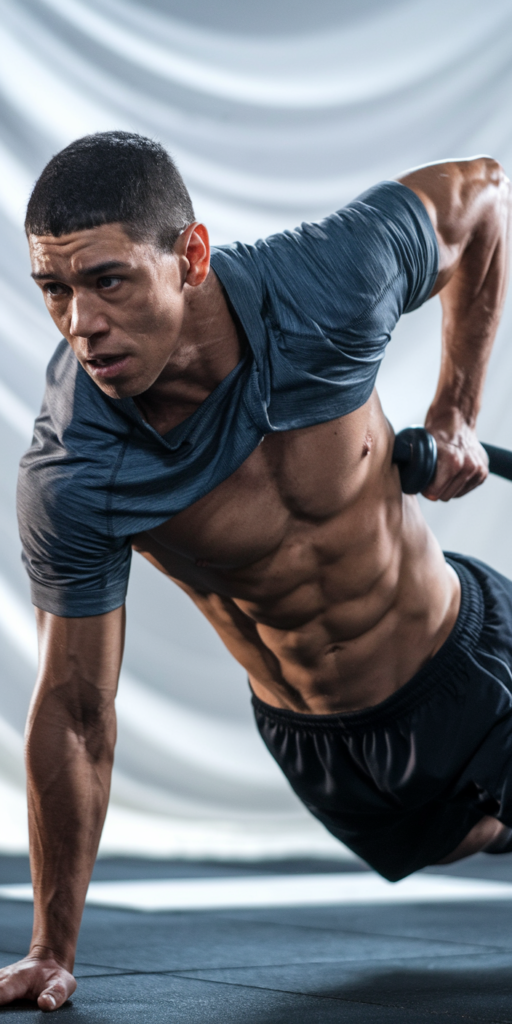
Planks are a fundamental bodyweight exercise that strengthen the entire core while also engaging the shoulders, glutes, and lower back. Unlike traditional crunches, planks focus on isometric contraction, meaning your muscles are activated without movement, which improves stability, posture, and overall functional strength. A strong core not only enhances performance in other gym exercises like squats and deadlifts but also reduces the risk of injury in daily activities.
How to Do It Properly:
- Starting Position: Begin on the floor, resting on your forearms and toes. Keep your elbows directly under your shoulders.
- Align Your Body: Engage your core, squeeze your glutes, and keep your body in a straight line from head to heels. Avoid letting your hips sag or pike upward.
- Hold the Position: Maintain the plank position for the desired duration, focusing on breathing steadily and keeping tension in your core muscles.
- Progression: To make it harder, try side planks, plank shoulder taps, or adding weight on your back.
Duration & Sets: Start with 3–4 sets of 20–60 seconds. Gradually increase hold time as your core strength improves.
Pro Tips for Maximum Results:
- Engage All Core Muscles: Think about pulling your belly button toward your spine and tightening your obliques.
- Avoid Dropping Hips: Sagging hips reduce effectiveness and can strain the lower back.
- Breathe Deeply: Don’t hold your breath—steady breathing maintains endurance.
- Add Variation: Side planks or plank leg lifts target additional core muscles and prevent plateaus.
- Consistency: Daily or every-other-day practice improves core strength faster than occasional sessions.
Why It Matters: Planks are a full-core strengthening exercise that improves stability, posture, and functional strength.
They are essential for anyone serious about strength training, as a strong core enhances performance in nearly every gym workout, from squats and deadlifts to overhead presses.
Gym Workouts for Fat Loss & Endurance
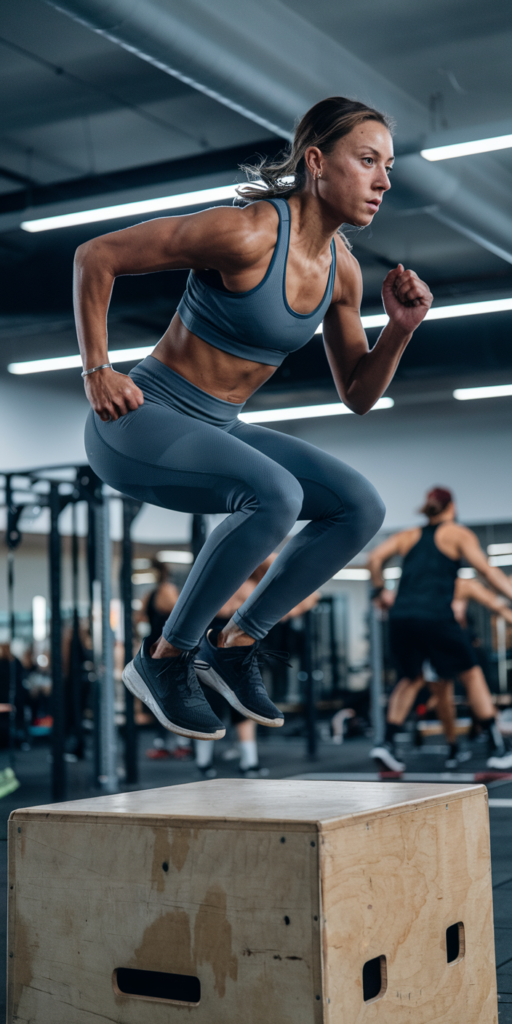
If your goal is burning fat while improving cardiovascular fitness and muscular endurance, the right gym workouts can accelerate results. By combining high-intensity training, functional exercises, and strength work, you can increase calorie burn, boost metabolism, and improve overall stamina.
Below, we’ve outlined the best gym workouts for fat loss and endurance, how to perform them correctly, and tips to maximize effectiveness.
1️⃣ Treadmill Intervals (Targets: Cardiovascular System, Legs)
Treadmill intervals are a simple yet highly effective method for burning calories and improving endurance. Alternating between high-intensity sprints and low-intensity recovery periods keeps your heart rate elevated and boosts fat loss.
How to Do It Properly:
- Warm up with a 5-minute walk or light jog.
- Sprint at high speed for 30–60 seconds.
- Recover by walking or slow jogging for 1–2 minutes.
- Repeat 8–12 cycles depending on your fitness level.
Pro Tips:
- Adjust sprint/recovery ratio as your endurance improves.
- Keep proper running form to avoid injuries—land mid-foot and engage your core.
- Incline can be added to increase intensity and target glutes/hamstrings.
2️⃣ Rowing Machine (Targets: Full Body, Cardiovascular System)
The rowing machine provides a full-body workout that combines cardio and strength. It burns calories efficiently while engaging the back, arms, legs, and core.
How to Do It Properly:
- Sit on the machine, feet strapped in, and grip the handle.
- Push through your legs while leaning slightly back, then pull the handle toward your chest.
- Reverse the movement by extending arms and bending knees for the recovery phase.
- Maintain smooth, controlled strokes at a moderate to high pace.
Duration: 15–30 minutes of steady-state rowing or 10–15 minutes of interval rowing.
Pro Tip: Focus on leg drive rather than overusing your arms—your legs generate most of the power.
3️⃣ Circuit Training (Targets: Full Body, Cardiovascular System, Muscular Endurance)
Circuit training alternates between strength and cardio exercises with minimal rest, keeping your heart rate elevated and improving endurance while burning fat.
Example Circuit:
- Jump squats – 15 reps
- Push-ups – 12–15 reps
- Kettlebell swings – 15 reps
- Mountain climbers – 30 seconds
- Dumbbell rows – 12 reps per arm
How to Perform:
- Complete each exercise back-to-back without rest.
- Rest 1–2 minutes between circuits.
- Repeat 3–4 rounds for a full session.
Pro Tip: Choose weights and intensity levels that challenge you but allow proper form.
4️⃣ High-Intensity Interval Training (HIIT) (Targets: Cardiovascular System, Full Body, Fat Loss)
HIIT alternates between short bursts of maximum effort and recovery periods. It is highly effective for accelerating fat loss and improving endurance because it increases post-exercise calorie burn (EPOC effect).
Example HIIT Routine:
- 30 seconds: Burpees
- 30 seconds: Rest
- 30 seconds: Kettlebell swings
- 30 seconds: Rest
- Repeat 8–10 rounds
Pro Tips:
- Warm up thoroughly before HIIT to prevent injuries.
- Focus on quality over quantity—control every movement.
- Cool down and stretch to aid recovery.
5️⃣ Stair Climber or Step Machine (Targets: Legs, Glutes, Cardiovascular System)
The stair climber provides low-impact cardio while targeting your legs and glutes. It’s excellent for improving endurance and lower-body strength simultaneously.
How to Do It Properly:
- Maintain an upright posture with shoulders back and core engaged.
- Avoid leaning heavily on handles; let your legs do the work.
- Adjust speed and resistance based on your fitness level.
Duration: 15–25 minutes for steady-state or interval climbs.
Pro Tip: Add intervals by alternating between fast-paced climbs and slower recovery steps to increase fat burn.
Tips for Maximum Fat Loss & Endurance Gains
- Combine Cardio and Strength: Pairing weight training with cardio enhances calorie burn and prevents muscle loss.
- Short, Intense Workouts: 30–45 minutes of focused training is often more effective than long, slow sessions.
- Progressive Overload: Gradually increase weight, intensity, or duration to continue improving.
- Proper Nutrition: Fuel workouts with lean protein, complex carbs, and healthy fats to support endurance and recovery.
- Consistency: 3–5 gym sessions per week are ideal for noticeable fat loss and stamina improvement.
Pro Tip: Mixing HIIT, circuits, and steady-state cardio keeps your workouts engaging, prevents plateaus, and ensures you’re targeting both fat loss and endurance effectively.
1. Treadmill HIIT
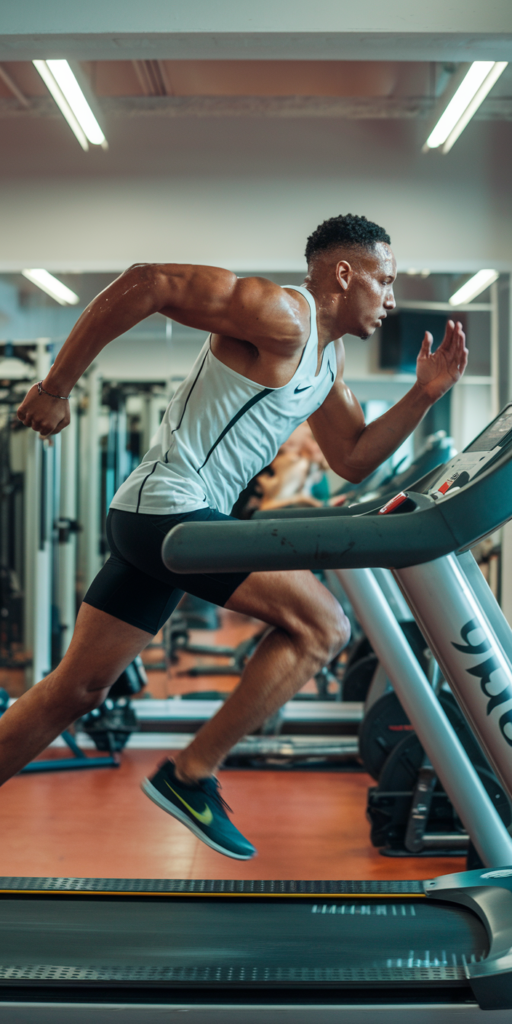
Treadmill HIIT (High-Intensity Interval Training) is one of the most effective workouts for burning fat, improving cardiovascular fitness, and building muscular endurance.
Unlike steady-state cardio, HIIT alternates between short bursts of intense sprinting and periods of slower recovery, which keeps your heart rate elevated and maximizes calorie burn both during and after your workout.
It’s perfect for people with limited time who want fast, efficient results without spending hours on the treadmill.
How to Do It Properly:
- Warm-Up: Begin with a 5–10 minute walk or light jog to prepare your muscles and joints. This helps prevent injury and improves your sprint performance. Include dynamic stretches like leg swings, high knees, and arm circles to activate the entire body.
- Sprint Interval: Increase the treadmill speed to a challenging sprint pace for 20–60 seconds. Focus on driving your knees up, keeping a tall posture, and pumping your arms efficiently. Your sprint should feel intense but manageable for the full interval.
- Recovery Interval: Reduce the treadmill speed to a walk or light jog for 60–120 seconds, depending on your fitness level. Use this time to recover, but keep your core engaged and maintain good posture.
- Repeat: Alternate between sprinting and recovery for 8–12 cycles. Beginners can start with fewer cycles, while more advanced exercisers can increase the number or intensity of sprints.
- Cool Down: Finish with a 5–10 minute slow walk to gradually bring your heart rate down. Follow up with static stretches targeting hamstrings, quads, glutes, and calves to improve flexibility and reduce muscle soreness.
Duration: 25–35 minutes including warm-up and cool-down
Pro Tips for Maximum Results:
- Form Matters: Keep your torso upright and avoid leaning too far forward. Proper running form improves efficiency and reduces the risk of injury.
- Adjust Intensity Gradually: Increase speed, incline, or interval duration as your fitness improves. For added challenge, try a slight incline to engage glutes and hamstrings more.
- Monitor Heart Rate: Aim to reach 80–90% of your maximum heart rate during sprints for optimal fat-burning benefits.
- Consistency is Key: Perform treadmill HIIT 2–3 times per week, combined with strength training, for the best fat loss and endurance results.
- Listen to Your Body: If you feel dizzy or overly fatigued, reduce speed or increase recovery time. Safety always comes first.
Why It Matters: Treadmill HIIT is more than just running—it’s a full-body conditioning workout that efficiently burns fat, strengthens legs and glutes, and improves cardiovascular endurance.
The post-exercise calorie burn, known as the afterburn effect, keeps your metabolism elevated for hours, making it one of the most time-effective workouts for fat loss and endurance improvement.
2. Rowing Machine
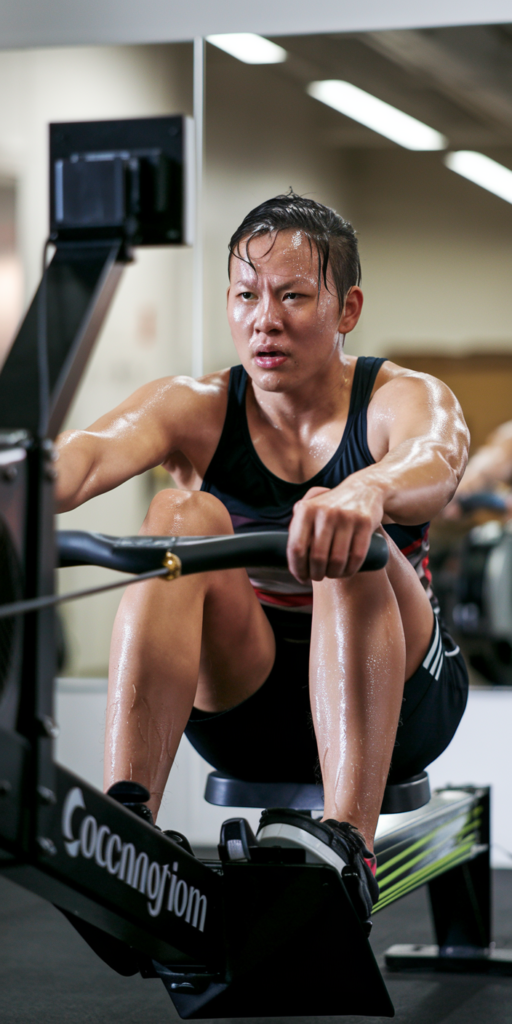
The rowing machine is one of the most underrated tools for fat loss and endurance in the gym. It provides a full-body, low-impact workout that engages your legs, back, shoulders, arms, and core simultaneously.
Unlike traditional cardio machines, rowing combines strength and cardiovascular training, allowing you to build muscular endurance while torching calories efficiently.
Rowing intervals, in particular, elevate your heart rate, improve aerobic and anaerobic fitness, and accelerate fat-burning metabolism.
How to Do It Properly:
- Warm-Up: Start with 5–10 minutes of light rowing at a comfortable pace. Focus on smooth, controlled strokes and activate your leg drive, back, and core.
- The Rowing Stroke:
- Leg Drive: Push off with your legs first, extending them fully while keeping your arms straight.
- Body Swing: Lean back slightly at the hips while keeping your core tight.
- Arm Pull: Pull the handle toward your chest just below your ribs, elbows close to your body.
- Return: Reverse the motion—extend your arms, hinge at the hips, and bend your knees to return to the starting position.
- Interval Training: Alternate between high-intensity sprints and moderate recovery:
- Sprint Interval: Row as fast as possible for 30–60 seconds while maintaining proper form.
- Recovery Interval: Row at a light to moderate pace for 60–120 seconds to allow partial recovery.
- Repeat for 8–12 cycles depending on your fitness level.
- Cool Down: Finish with 5 minutes of light rowing and gentle stretching, focusing on hamstrings, quads, back, and shoulders.
Duration: 20–35 minutes including warm-up and cool-down
Pro Tips for Maximum Results:
- Engage Legs First: Most people overuse their arms; remember that your legs generate the majority of power.
- Keep Core Tight: A strong core stabilizes your body and protects your lower back during sprints.
- Monitor Your Stroke Rate: Aim for 24–30 strokes per minute during sprints for maximum efficiency.
- Progressive Overload: Gradually increase sprint duration, resistance, or number of intervals over time to continue improving endurance and calorie burn.
- Form Over Speed: Focus on smooth, controlled movements rather than rowing frantically; proper form maximizes muscle engagement and reduces injury risk.
Why It Matters: Rowing machine intervals are a full-body fat-burning powerhouse. They not only improve cardiovascular endurance and calorie expenditure but also strengthen key muscle groups like the back, legs, and core.
When combined with other gym workouts, rowing intervals can significantly accelerate fat loss while improving functional strength and overall stamina.
3. Circuit Training
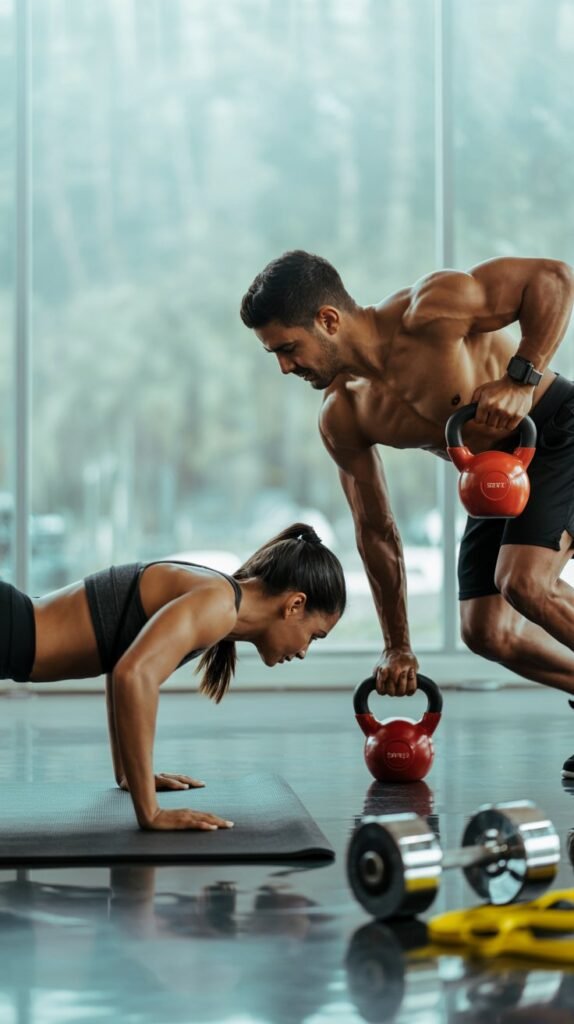
Circuit training is one of the most effective gym workouts for fat loss and endurance because it combines strength and cardio exercises with minimal rest.
By moving quickly from one exercise to the next, your heart rate stays elevated, calories are burned efficiently, and your muscles are challenged across multiple groups.
Circuit training also improves functional strength, stamina, and metabolic conditioning, making it ideal for anyone looking to maximize results in a shorter workout session.
How to Do It Properly:
- Choose Your Exercises: Pick 5–8 exercises that target different muscle groups to ensure a full-body workout. For example:
- Jump squats (legs & glutes)
- Push-ups (chest & triceps)
- Kettlebell swings (posterior chain & core)
- Mountain climbers (core & cardio)
- Dumbbell rows (back & biceps)
- Burpees (full body & cardio)
- Structure Your Circuit:
- Perform each exercise for 30–60 seconds, maintaining proper form.
- Move to the next exercise with minimal rest (15–30 seconds).
- Complete the full circuit and rest for 1–2 minutes before repeating.
- Repeat 3–4 rounds depending on your fitness level.
- Focus on Form and Pace: While speed keeps your heart rate up, ensure that each rep is performed correctly to maximize muscle engagement and reduce injury risk.
- Include a Warm-Up & Cool-Down:
- Warm-up with 5–10 minutes of dynamic movements (e.g., jumping jacks, leg swings, arm circles).
- Cool down with 5–10 minutes of light cardio and static stretches focusing on worked muscles.
Duration: 30–45 minutes including warm-up and cool-down
Pro Tips for Maximum Results:
- Balance Exercises: Include both upper- and lower-body movements as well as core and cardio exercises.
- Progressive Overload: Increase weight, reps, or circuit rounds gradually to continuously challenge your body.
- Use Compound Movements: Exercises that engage multiple muscle groups burn more calories and improve functional strength.
- Minimize Rest: Keep transitions short to maintain elevated heart rate and maximize fat-burning potential.
- Customize Intensity: Beginners can reduce work time or increase rest periods; advanced individuals can shorten rest or add resistance for a tougher workout.
Why It Matters: Circuit training is an all-in-one fat-loss and endurance solution. It improves cardiovascular health, builds muscular endurance, and promotes calorie burn during and after workouts.
Because circuits combine strength and cardio, they prevent plateaus, save time, and keep your workouts dynamic and engaging.
Common Gym Workout Mistakes & Fixes
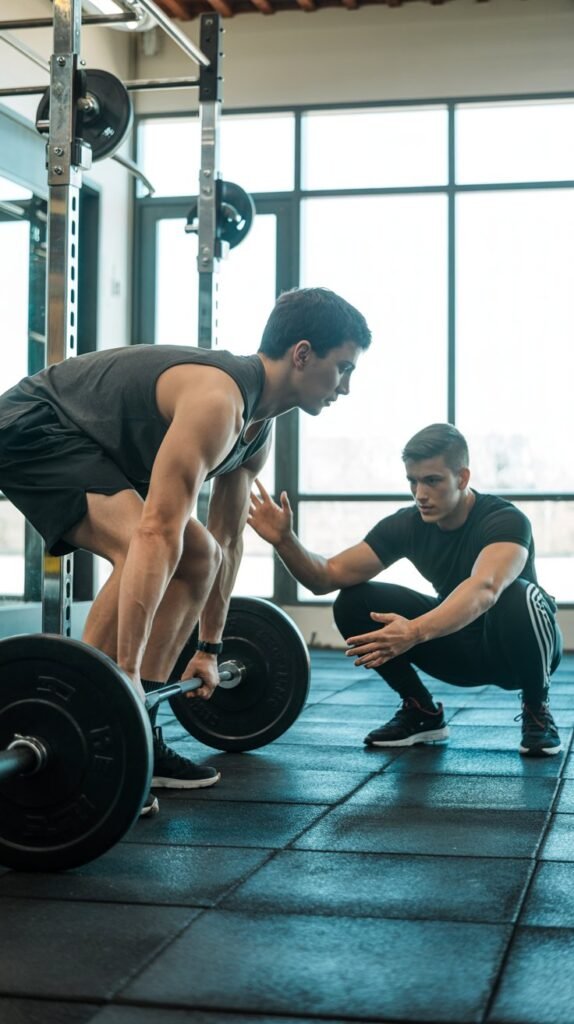
Even the most dedicated gym-goers can fall into common pitfalls that limit progress, increase injury risk, and slow fat loss or muscle gains.
Recognizing and correcting these mistakes ensures your workouts are safe, efficient, and results-driven.
1️⃣ Skipping Warm-Ups
Mistake: Jumping straight into heavy lifting or intense cardio.
Why It’s a Problem: Cold muscles are more prone to strains, sprains, and injuries. Performance may also be compromised.
Fix: Spend 5–10 minutes warming up with light cardio and dynamic stretches (arm circles, leg swings, bodyweight squats). This increases blood flow, loosens joints, and primes muscles for exercise.
2️⃣ Poor Form During Exercises
Mistake: Sacrificing technique to lift heavier weights or go faster.
Why It’s a Problem: Incorrect form reduces effectiveness and increases injury risk. Common issues include rounded backs in deadlifts, flared elbows in bench presses, or swinging weights in curls.
Fix: Focus on controlled, deliberate movements. Use mirrors or ask a trainer to check your form. Start with lighter weights to master technique before increasing load.
3️⃣ Ignoring Progressive Overload
Mistake: Lifting the same weights or doing the same reps for months without increasing intensity.
Why It’s a Problem: Muscles adapt quickly, and without progressive overload, growth and fat loss plateau.
Fix: Gradually increase weight, reps, sets, or reduce rest time over time. Track progress to ensure continuous improvement.
4️⃣ Overtraining or Lack of Rest
Mistake: Working out intensely every day without giving your body time to recover.
Why It’s a Problem: Leads to fatigue, decreased performance, muscle breakdown, and increased injury risk.
Fix: Incorporate rest days and alternate between muscle groups. Quality sleep and proper nutrition are essential for recovery and muscle growth.
5️⃣ Not Tracking Workouts
Mistake: Performing random exercises without recording progress.
Why It’s a Problem: Without tracking, you can’t measure improvement or know when to increase intensity.
Fix: Keep a workout log or use an app to track exercises, weights, reps, and duration. This helps set goals and motivates consistent progress.
6️⃣ Neglecting Nutrition
Mistake: Assuming workouts alone will lead to fat loss or muscle growth.
Why It’s a Problem: Without proper nutrition, results are limited. Overeating, under-eating, or lacking protein impairs performance and recovery.
Fix: Follow a balanced diet rich in lean protein, complex carbs, healthy fats, and micronutrients. Fuel workouts and recover effectively to maximize results.
7️⃣ Using Machines Exclusively
Mistake: Relying solely on gym machines instead of incorporating free weights and functional exercises.
Why It’s a Problem: Machines often isolate muscles and limit functional strength, reducing overall muscle coordination and balance.
Fix: Incorporate compound movements like squats, deadlifts, bench presses, and pull-ups. Machines can supplement, but free weights improve strength, stability, and overall performance.
8️⃣ Rushing Through Workouts
Mistake: Trying to finish workouts as quickly as possible.
Why It’s a Problem: Skipping rest, using momentum, or cutting sets short reduces effectiveness and increases risk of injury.
Fix: Focus on quality over speed. Rest as needed, maintain proper form, and control movements for maximum results.
Final Thought: Avoiding these common mistakes ensures your gym workouts are safe, effective, and optimized for fat loss, endurance, and muscle growth. Small corrections can lead to big improvements in performance and results over time.
Gym Workout Plan for Beginners
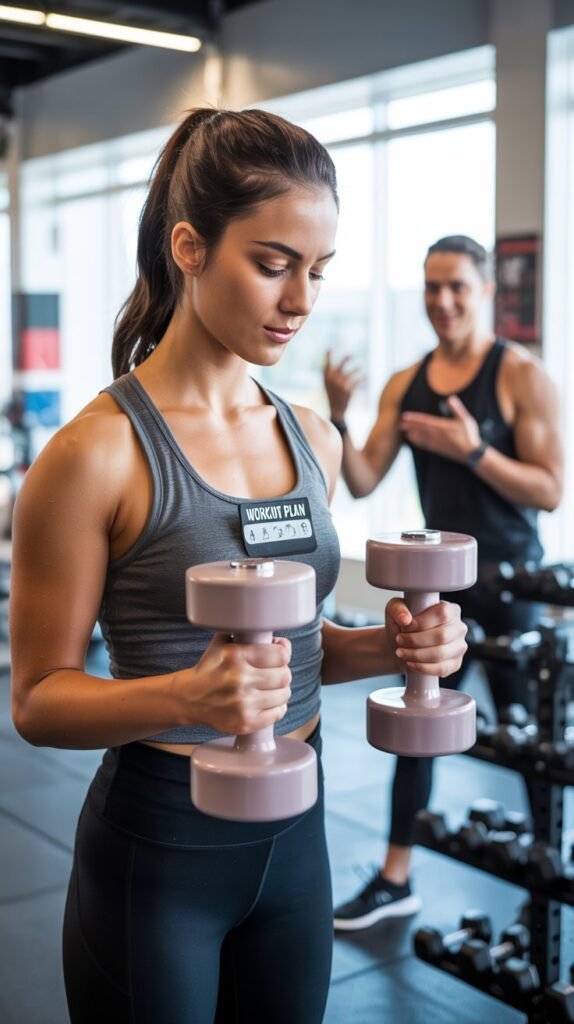
Starting at the gym can feel overwhelming, but a structured beginner workout plan makes it easy to build strength, burn fat, and improve endurance safely.
This plan focuses on full-body workouts, proper form, and balanced progression, so you gain confidence and see results without overtraining.
Workout Schedule (3 Days a Week)
- Day 1: Full-Body Strength
- Day 2: Cardio & Core
- Day 3: Full-Body Strength
- Rest days can be active (light walking, stretching) or complete rest.
Day 1: Full-Body Strength
1️⃣ Squats (Quads, Glutes, Hamstrings)
- 3 sets of 10–12 reps
- Keep feet shoulder-width apart, chest up, and knees behind toes.
- Focus on controlled movement and depth that feels comfortable.
2️⃣ Dumbbell Bench Press (Chest, Shoulders, Triceps)
- 3 sets of 10–12 reps
- Lower dumbbells slowly, press up explosively while keeping shoulders stable.
3️⃣ Lat Pulldown (Back, Biceps)
- 3 sets of 10–12 reps
- Pull bar to your chest while keeping core engaged and avoiding swinging.
4️⃣ Dumbbell Shoulder Press (Shoulders, Triceps)
- 3 sets of 10–12 reps
- Press overhead while keeping core tight and back neutral.
5️⃣ Planks (Core, Glutes, Shoulders)
- 3 sets, hold 20–40 seconds each
- Keep a straight line from head to heels, engage abs and glutes.
Day 2: Cardio & Core
1️⃣ Treadmill Intervals
- 20 minutes alternating 30 seconds sprint / 90 seconds walk
- Focus on form, core tight, and breathing steadily.
2️⃣ Rowing Machine Intervals
- 10–15 minutes alternating 30 seconds high-intensity / 60 seconds moderate pace
- Legs drive the motion, arms follow, core engaged.
3️⃣ Bicycle Crunches (Core, Obliques)
- 3 sets of 15–20 reps per side
- Slow, controlled motion for maximum engagement.
4️⃣ Russian Twists (Core, Obliques)
- 3 sets of 20 reps (10 each side)
- Hold a light weight or medicine ball, twist from the torso, not just arms.
Day 3: Full-Body Strength (Variation)
1️⃣ Deadlifts (Hamstrings, Glutes, Lower Back)
- 3 sets of 10 reps
- Keep back straight, hinge at the hips, lift with legs and glutes.
2️⃣ Dumbbell Rows (Back, Biceps)
- 3 sets of 10–12 reps per arm
- Pull dumbbell toward ribcage, avoid twisting the torso.
3️⃣ Lunges (Quads, Glutes, Hamstrings)
- 3 sets of 10 reps per leg
- Step forward, lower back knee toward floor, keep chest upright.
4️⃣ Dumbbell Bicep Curls (Biceps)
- 3 sets of 12 reps
- Keep elbows close to body, slow up and down movement.
5️⃣ Triceps Kickbacks (Triceps)
- 3 sets of 12 reps
- Hinge forward slightly, extend arms behind with control.
Beginner Tips:
- Warm-Up & Cool-Down: Always spend 5–10 minutes on dynamic warm-up and light stretching afterward.
- Focus on Form: Quality reps matter more than heavy weights.
- Rest: Take 60–90 seconds between sets.
- Progress Gradually: Increase weights, reps, or sets over time to avoid plateaus.
- Hydrate & Fuel: Eat protein-rich meals and stay hydrated to support recovery.
Why It Works: This beginner-friendly plan builds strength, endurance, and confidence, while preventing injury. It targets all major muscle groups, combines cardio and strength, and establishes a solid foundation for more advanced gym workouts.
Nutrition Tips for Gym Success
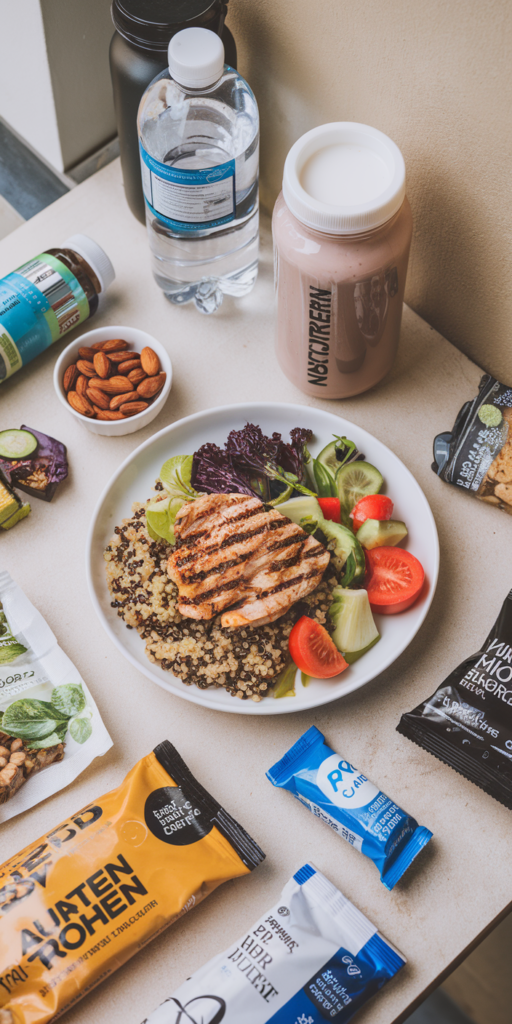
Your gym results are heavily influenced by what you eat. Even the most well-structured workout plan won’t be as effective without proper nutrition.
Fueling your body correctly improves performance, enhances recovery, supports fat loss, and maximizes muscle growth. Here’s a detailed guide to nutrition strategies for gym success:
1️⃣ Prioritize Protein
Why It Matters: Protein is essential for muscle repair and growth. Consuming adequate protein helps your body recover faster, maintain lean muscle, and burn more calories through thermogenesis.
How to Implement:
- Aim for 0.8–1 gram of protein per pound of body weight daily.
- Include sources like lean meats (chicken, turkey, beef), fish, eggs, Greek yogurt, cottage cheese, and plant-based proteins like tofu, tempeh, or legumes.
- Spread protein intake across meals to optimize muscle protein synthesis.
2️⃣ Include Complex Carbs
Why It Matters: Carbohydrates are your body’s main energy source. Eating the right type and timing of carbs fuels workouts and replenishes glycogen stores for better performance.
How to Implement:
- Focus on whole grains, brown rice, oats, quinoa, sweet potatoes, and fruits.
- Eat carbs before workouts to provide energy and after workouts to aid recovery.
- Limit refined sugars, which can spike blood sugar and contribute to fat gain.
3️⃣ Don’t Fear Healthy Fats
Why It Matters: Healthy fats support hormone production, including testosterone, which is crucial for muscle growth and fat loss.
How to Implement:
- Include sources like avocados, nuts, seeds, olive oil, and fatty fish.
- Use fats as part of balanced meals, not as isolated snacks high in calories with low nutrition.
4️⃣ Stay Hydrated
Why It Matters: Water regulates body temperature, improves nutrient transport, and prevents fatigue during workouts. Even mild dehydration can impair performance and recovery.
How to Implement:
- Aim for half your body weight in ounces of water daily.
- Drink water before, during, and after workouts.
- Include electrolyte-rich beverages if doing high-intensity or long-duration sessions.
5️⃣ Time Your Meals Strategically
Why It Matters: Nutrient timing affects energy levels and recovery. Eating the right foods at the right time maximizes your workout efficiency.
How to Implement:
- Pre-Workout: Eat a balanced meal 60–90 minutes before training with carbs + protein (e.g., oatmeal with whey protein).
- Post-Workout: Consume protein + carbs within 30–60 minutes to support recovery (e.g., chicken with sweet potato or protein shake with banana).
- Snacks: Healthy snacks like nuts, yogurt, or fruit can sustain energy throughout the day.
6️⃣ Limit Processed Foods & Added Sugars
Why It Matters: Highly processed foods can lead to fat gain, inflammation, and poor energy levels. They often lack the nutrients needed to support workout recovery.
How to Implement:
- Focus on whole, nutrient-dense foods: vegetables, fruits, lean proteins, and whole grains.
- Read labels to avoid hidden sugars, unhealthy oils, and excessive sodium.
7️⃣ Supplement Wisely
Why It Matters: While not required, supplements can help fill nutritional gaps and support performance.
Common Options:
- Protein powder for convenient post-workout recovery.
- Creatine to boost strength and muscle growth.
- BCAAs or EAAs during long workouts to prevent muscle breakdown.
- Multivitamins if dietary intake is insufficient.
Final Tip: Nutrition and training go hand-in-hand. Focus on balanced meals, proper hydration, and meal timing to fuel your workouts, speed up recovery, and maximize results. Pairing a smart gym plan with the right nutrition ensures you get stronger, leaner, and fitter faster.
Conclusion
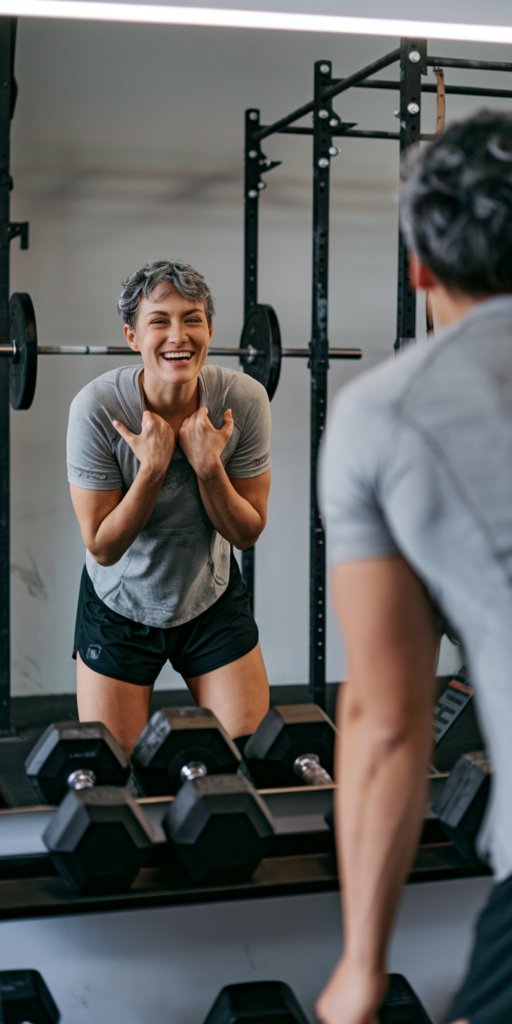
Achieving your fitness goals isn’t just about showing up at the gym—it’s about combining smart workouts with proper nutrition, recovery, and consistency. Whether your focus is strength, fat loss, endurance, or overall health, following a structured plan ensures that every session counts.
By incorporating full-body exercises, HIIT, circuit training, and progressive strength work, you challenge all major muscle groups while improving cardiovascular fitness. Pairing these workouts with protein-rich meals, balanced carbs, healthy fats, and proper hydration maximizes results and supports muscle recovery.
Remember, consistency is key. Small, consistent efforts compound over time, leading to significant improvements in strength, endurance, and body composition. Avoid common mistakes, listen to your body, and progressively challenge yourself to keep advancing.
Final Thought: Fitness is a journey, not a sprint. By combining effective gym workouts, smart nutrition, and disciplined recovery, you create a sustainable path to better health, increased energy, and a stronger, fitter body.
Frequently Asked Questions (FAQs) About Gym Workouts
Here’s a comprehensive FAQ section to answer common questions beginners and intermediate gym-goers often have.
1️⃣ How Often Should I Go to the Gym?
For beginners, 3 days a week of full-body workouts is ideal to build strength and allow recovery. Intermediate or advanced lifters may go 4–5 days per week, splitting muscle groups or combining strength and cardio sessions.
2️⃣ How Long Should My Workouts Be?
A typical gym session should last 45–75 minutes, including warm-up and cool-down. Strength-focused workouts may be shorter with heavier weights, while HIIT or circuit sessions may be slightly longer due to cardio intervals.
3️⃣ Do I Need Supplements to See Results?
Supplements are optional. Protein powder, creatine, or multivitamins can support performance and recovery, but they are not a substitute for a balanced diet rich in whole foods.
4️⃣ How Important Is Nutrition for Gym Results?
Nutrition is crucial. Eating protein-rich meals, complex carbs, healthy fats, and staying hydrated fuels workouts, supports recovery, and maximizes fat loss and muscle gain. Even the best workouts are less effective without proper nutrition.
5️⃣ Can I Lose Fat and Build Muscle at the Same Time?
Yes, especially for beginners or those returning after a break. Focus on strength training, HIIT, and a slight calorie deficit with high protein intake. Over time, this approach helps build lean muscle while reducing body fat.
6️⃣ What’s Better for Fat Loss: Cardio or Strength Training?
Both are important. Strength training builds muscle and boosts metabolism, while cardio (especially HIIT) burns calories and improves cardiovascular health. A combination of both yields the best fat-loss results.
7️⃣ How Do I Avoid Injuries at the Gym?
- Warm up properly before each session.
- Focus on proper form instead of lifting heavy weights too soon.
- Progress gradually in weights, reps, and intensity.
- Listen to your body—rest if you feel pain or excessive fatigue.
8️⃣ Can I Do Gym Workouts at Home?
Yes! Many gym exercises have home alternatives using dumbbells, resistance bands, or bodyweight exercises. HIIT, circuit training, and strength routines can all be adapted for home use.
Tip: Track your workouts, meals, and progress. Monitoring results helps you adjust your plan, stay motivated, and continue improving safely and effectively.
